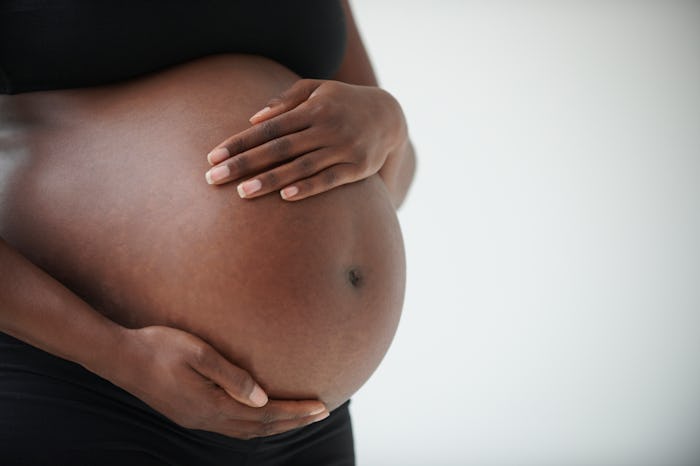Birth

How To Make Your Baby Drop & Engage
Sometimes babies like to take their time.
Doesn’t the last trimester of pregnancy feel like the longest of all? You’d swear it was longer than the rest of your pregnancy combined. At this point, you’re probably ready for that baby to get locked and loaded in your pelvis so they can vacate the premises as soon as possible — especially if it feels like you can’t breathe because they’re all up in your ribcage and lungs. You might want to speed up the process and get the ball rolling, or maybe even try to induce labor naturally at home. How do you get your baby to “drop?”
Before you try any marathon anything (whether that’s sex or jogging), it may be helpful to figure out what it means for your baby to “drop,” when you can expect it to happen, and how soon you’ll be able to go into labor after it happens.
What does it mean for baby to drop?
The technical definition is when your baby’s head enters the pelvis and is “head-down," says OB-GYN Dr. Idries Abdur-Rahman, M.D., author of Everything You Ever Wanted to Know About Pregnancy (But Were Too Afraid or Embarrassed To Ask) and one half of the Twin Doctors for TwinDoctorsTV.
“The baby will generally be in the head-down position by about 32 weeks of pregnancy (7 months), but even when the baby is head down, his or her head can still be high above the pelvic bones. Once a baby drops, his or her head settles into the pelvis,” he says.
What week does baby usually drop?
“A person in their first pregnancy may feel their baby drop between 36 to 38 weeks of their pregnancy,” says Nadia Graves, a certified nurse midwife with Quilted Health.
Abdur-Rahman says it depends on the person and the pregnancy — so it varies — but most babies will eventually engage on their own without help from mom at different times of pregnancy. “First babies tend to engage later in pregnancy while second babies and beyond tend to engage earlier. Having said that, there are certain exercises that mothers-to-be can do to encourage a baby to engage,” he says.
How can you make your baby drop?
First, says Graves, it helps to stay really well-hydrated and practice prenatal stretches daily. This will help “soften and relax your soft tissues” like the muscles and ligaments around your pelvic area, which can help your baby to drop and engage. Graves also recommends walking for 15 to 30 minutes four to five times a week as well.
She adds, “If you have a birth ball or exercise ball at home, you can sit on that and move your hips in circles or a figure-eight motion, which can help change the diameters in the pelvis and allow the baby to drop.” Graves also suggests doing squats and lunges to help get your baby engaged. “Remember that your balance changes during pregnancy, so make sure you are supported and in a safe space before doing lunges and squats,” she says. “Dancing is also a great way to release feel-good hormones, have a moment of joy, and allow your pelvis and hips to create space for the baby to drop.”
In addition to the above, Abdur-Rahman also suggests “good old fashioned walking.”
“Nothing beats gravity when it comes to encouraging a baby to engage,” he says.
After doing all of these exercises, how will you know if it actually worked and the baby has dropped and engaged?
How do you know when your baby is dropped?
“Some women might feel more pressure over their bladder, less heartburn or more appetite," says Dr. Lisa Valle, M.D., an OB-GYN at Providence Saint John’s Health Center in Santa Monica, California.
"Others might find it easier to breathe because there is more room in the abdominal activity now that the baby has moved down into the pelvis.” Abdur-Rahman concurs, adding that you may also notice an increase in vaginal discharge.
According to Graves, “A person who has had a baby in the past may feel like their baby ‘sits low’ during the entirety of their pregnancy, so they may not get the feeling that their baby has dropped,” she says. Usually, you can tell that your baby has dropped because you will feel more pelvic pressure and it will likely be easier to breathe since the baby is not taking up so much space near your lungs.
Once the baby has dropped, how soon you'll give birth varies from woman to woman.
How soon will you give birth after baby drops?
Graves says that a person who hasn’t given birth before may go into labor two to four weeks after their baby has dropped, and some people don’t even feel their baby drop until they’re in labor.
“Unfortunately, there is no real correlation between when a baby drops and when you will go into labor,” Abdur-Rahman says.
“Every pregnancy is different, and every pregnant person may have a different experience,” Graves says. “If you do not feel like your baby has dropped, no need to worry — keep calm and gestate on!”
So if you’re trying to get your baby to drop and engage, remember that gravity is your friend, and keep trying exercises that focus on your pelvis opening up to get the baby to drop down, including pelvic squats, bouncing on a birthing ball, or just going on a walk.
Sources:
Dr. Idries Abdur-Rahman, OB-GYN, author of Everything You Ever Wanted to Know About Pregnancy (But Were Too Afraid or Embarrassed To Ask) and one half of the Twin Doctors for TwinDoctorsTV.
Dr. Lisa Valle, OB-GYN at Providence Saint John’s Health Center in Santa Monica, California
Nadia Graves, a certified nurse midwife with Quilted Health.
This article was originally published on